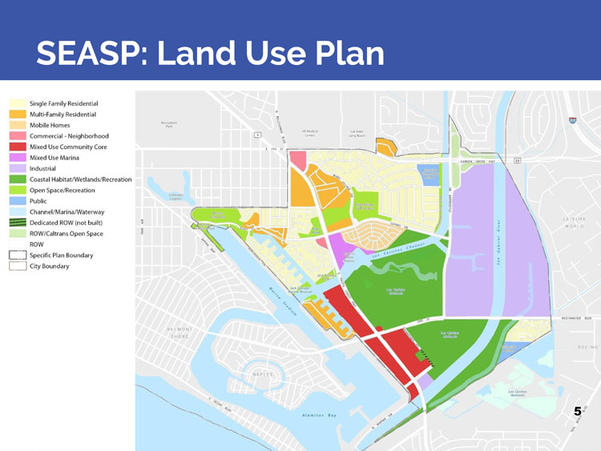The board of directors of The Los Cerritos Wetlands Land Trust sued the City of Long Beach over its approval of a land use plan that permits the construction of taller buildings and more density near a coastal habitat.
The area in question is located in the southeast corner of Long Beach, bordering Orange County to the east and south and the Pacific Ocean on the southwest. It comprises 1,472 acres of land south of 7th Street, east of Bellflower Boulevard and north and west of the city’s border, as outlined in the plan. (See below map)

Pictured is the Southeast Area Specific plan, which the Long Beach City Council approved on September 19. The Los Cerritos Wetlands Trust has sued the city, claiming that the plan does not provide adequate environmental protections. (Map provided by the City of Long Beach)
The city council approved the Southeast Area Specific Plan (SEASP) on September 19. The city’s advance planning officer, Christopher Koontz, said the blueprint focuses on redevelopment rather than adding on new buildings. It was designed to replace the Southeast Area Development and Improvement Plan (SEADIP), which hadn’t been updated since around 1977, he explained.
“The area is in the gateway location to the city, right as you come in from Seal Beach,” Koontz said. “It’s pretty dilapidated and definitely not our best foot forward.”
The new plan created environmental protections that had not existed before. The former plan allowed for development within the wetland areas, which SEASP now safeguards against. Another provision imposes an impact fee on all new developments to help cover restoration and monitoring of the wetlands. SEASP also provides protections for birds, and includes native plant landscaping.
Although the Los Cerritos Wetlands Land Trust expressed approval of the changes, these enhancements are not enough to offset the impacts of increased traffic and insufficient wetlands buffers, according to a statement from the organization.
“Our goal is to robustly preserve and protect the wetlands, and the plan approved by the city council does not sufficiently do that,” Los Cerritos Wetlands Land Trust Executive Director Elizabeth Lambe told the Business Journal. “[Filing the lawsuit] wasn’t an easy decision for us. But the SEASP area is a really special and unique area with some fragile ecosystems. The vast majority, [in] the high 90%, of California wetlands are lost forever. If you look at it in that context, then you need development nearby that is respectful and acknowledges the fragile habitat.”
The group took particular issue with the city’s approval of two seven-story hotels, 1,000 more dwelling units than had been allowed under SEADIP, and 300,000 square feet of new retail, the organization’s statement said.
Koontz said that the city conducted outreach meetings and that he personally spent “hundreds of hours” incorporating feedback from the Los Cerritos Wetlands Land Trust.
“Unfortunately, litigation has become part of the planning process,” he said. “We came up with a plan where some folks thought it was too much but then we also heard from landowners who said it didn’t have enough development opportunities. As a planner, you know you’ve reached that consensus point where everyone’s a little unhappy, but a little happy overall.”
Koontz predicted the lawsuit would take about 18 months to resolve, and said the city won’t move forward with any individual projects until then. But any incoming proposals will be evaluated based on the 1977 standards, which exclude many environmental protections.
